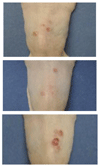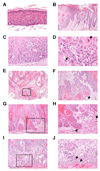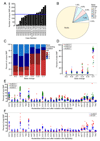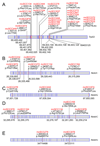Whole-Exome Sequencing Validates a Preclinical Mouse Model for the Prevention and Treatment of Cutaneous Squamous Cell Carcinoma
- PMID: 27923803
- PMCID: PMC5408961
- DOI: 10.1158/1940-6207.CAPR-16-0218
Whole-Exome Sequencing Validates a Preclinical Mouse Model for the Prevention and Treatment of Cutaneous Squamous Cell Carcinoma
Abstract
Cutaneous squamous cell carcinomas (cSCC) are among the most common and highly mutated human malignancies. Solar UV radiation is the major factor in the etiology of cSCC. Whole-exome sequencing of 18 microdissected tumor samples (cases) derived from SKH-1 hairless mice that had been chronically exposed to solar-simulated UV (SSUV) radiation showed a median point mutation (SNP) rate of 155 per Mb. The majority (78.6%) of the SNPs are C.G>T.A transitions, a characteristic UVR-induced mutational signature. Direct comparison with human cSCC cases showed high overlap in terms of both frequency and type of SNP mutations. Mutations in Trp53 were detected in 15 of 18 (83%) cases, with 20 of 21 SNP mutations located in the protein DNA-binding domain. Strikingly, multiple nonsynonymous SNP mutations in genes encoding Notch family members (Notch1-4) were present in 10 of 18 (55%) cases. The histopathologic spectrum of the mouse cSCC that develops in this model resembles very closely the spectrum of human cSCC. We conclude that the mouse SSUV cSCCs accurately represent the histopathologic and mutational spectra of the most prevalent tumor suppressors of human cSCC, validating the use of this preclinical model for the prevention and treatment of human cSCC. Cancer Prev Res; 10(1); 67-75. ©2016 AACR.
©2016 American Association for Cancer Research.
Conflict of interest statement
Figures




References
-
- Alam M, Ratner D. Cutaneous squamous-cell carcinoma. N Engl J Med. 2001;344:975–83. - PubMed
-
- Karia PS, Han J, Schmults CD. Cutaneous squamous cell carcinoma: estimated incidence of disease, nodal metastasis, and deaths from disease in the United States, 2012. J Am Acad Dermatol. 2013;68:957–66. - PubMed
-
- Levine DE, Karia PS, Schmults CD. Outcomes of Patients With Multiple Cutaneous Squamous Cell Carcinomas: A 10-Year Single-Institution Cohort Study. JAMA Dermatology. 2015;151:1220–5. - PubMed
Publication types
MeSH terms
Substances
Grants and funding
LinkOut - more resources
Full Text Sources
Other Literature Sources
Medical
Research Materials
Miscellaneous

